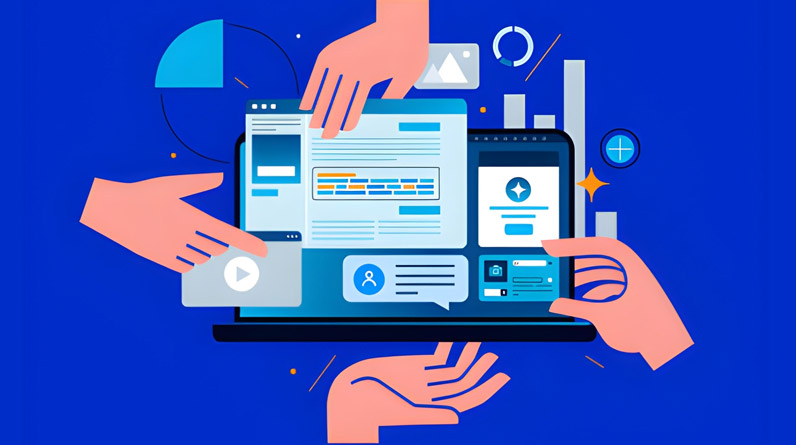Introduction: The First Impression That Matters
Did you know that visitors form an opinion about your brand in just 0.05 seconds? That’s faster than a blink. In today’s digital landscape, visual content isn’t optional—it’s essential. Whether you’re a small business owner, content creator, or social media marketer, the ability to create professional-looking graphics and videos has become a fundamental skill.
The challenge? Thousands of design and video editing apps flood the market, each promising to be the “easiest” or “most powerful.” For beginners, this abundance creates paralysis rather than possibility. Do you choose a simple tool that limits your growth? Or do you dive into complex software that might overwhelm you?
This guide takes a fresh approach. Instead of simply listing every available app, we’ll help you navigate the decision strategically—matching your specific needs, skill level, and budget to the right tools.
The Beginner’s Paradox: Why “Simple” Isn’t Always Better
The most common mistake beginners make is choosing tools based on simplicity alone. While drag-and-drop interfaces are appealing, they often come with hidden costs:
- Feature limitations that force you to upgrade quickly
- Time investment learning a tool’s quirks and workarounds
- Export restrictions that lock you into specific formats
- Template overuse that makes your designs look generic
The best beginner tools aren’t the simplest—they’re the ones that grow with you. They offer an accessible entry point but don’t sacrifice functionality as your skills develop.
How to Choose Your Perfect Design and Video Editing Tool
1. Assess Your Skill Level Honestly
There are three distinct beginner categories:
| Skill Level | Characteristics | Best Tool Type |
|---|---|---|
| Complete Novice | No design experience, prefers templates, wants quick results | Template-heavy, minimal customization required |
| Curious Learner | Wants to understand design principles, willing to invest time | Balanced tools with tutorials and flexibility |
| Ambitious Creator | Plans to build a career or business around design/video | Professional-grade tools with growth potential |
2. Define Your Primary Use Case
Are you creating:
- Social media content? (Instagram posts, TikTok videos, Pinterest pins)
- Business materials? (logos, business cards, presentations)
- Marketing collateral? (ads, email headers, landing pages)
- Personal projects? (portfolios, resumes, hobby content)
Each use case requires different priorities. Social media creators need quick turnaround times and platform-specific templates. Business-focused users need professional polish and brand consistency tools.
The Best Graphic Design Apps for Beginners in 2025
For Complete Novices: Template-First Approach
Canva remains the gold standard for beginners who need results fast. With over 610,000 templates, you’re guaranteed to find something close to what you envision. The drag-and-drop interface is genuinely intuitive, and the free version is surprisingly robust.
Pros:
- Massive template library (updated daily)
- 1 million+ stock images in free version
- Intuitive interface with minimal learning curve
- Perfect for social media (1TB cloud storage in Pro)
Cons:
- Templates often look recognizable (overused design patterns)
- Limited photo editing capabilities
- Lack of advanced customization options in free version
Best For: Social media managers, bloggers, small business owners who need quick, presentable designs.
Adobe Express is the underrated alternative. It offers a cleaner interface than Canva and includes a built-in social media scheduler for free—a feature Canva reserves for paid plans.
For Curious Learners: Balanced Tools
Adobe Spark bridges the gap between simplicity and capability. It includes a free social scheduler, background remover, and AI-powered features that most free tools charge for.
PhotoDirector offers something different: AI-powered photo enhancement alongside graphic design. If your designs rely heavily on photography, the built-in image editing tools are game-changers.
Key advantages:
- AI-powered tools (background removal, object removal, upscaling)
- Photo editing integrated with design features
- Responsive, modern interfaces
- Affordable premium tiers ($3-10/month)
For Ambitious Creators: Professional-Grade Tools
Figma dominates for UI/UX design and collaborative projects. While it’s more complex than Canva, beginners who invest time in learning it develop skills that translate to professional work.
Lunacy offers everything Figma provides—team collaboration for 100 people, cloud storage, vector editing—completely free. No paywalls. No locked features. This makes it exceptional for ambitious learners.
GIMP and Inkscape are open-source alternatives to expensive Adobe and CorelDRAW subscriptions. They have steep learning curves but unlimited potential.
The Best Video Editing Apps for Beginners in 2025
For Complete Novices: Auto-Editing Magic
CapCut is revolutionizing beginner video editing. The free version allows 8K exports at 60 frames per second—specs that many paid tools don’t offer. The interface is clean, and the text-to-speech and automatic captions features are genuinely impressive.
Key features:
- Drag-and-drop simplicity with surprising depth
- AI-powered features (avatar creation, voice generation, auto-captions)
- 8K export capability free
- Keyframe animation for advanced users
Adobe Premiere Rush takes a different approach: select your clips, click “Create,” and the software auto-edits them together. It’s perfect for creators who want professional results without the learning curve.
For Curious Learners: Balanced Capability
DaVinci Resolve is the game-changer in free video editing. Hollywood professionals use this tool—the free version includes professional-grade color grading, audio mastering, and effects. It’s not the easiest for beginners, but comprehensive tutorials make it accessible.
iMovie (Mac only) offers beginner-friendly simplicity with surprising power. The integration with Apple’s ecosystem means importing iPhone footage is seamless.
Clipchamp is the best web-based option. You can edit directly in your browser, eliminating installation hassles. Performance is surprisingly smooth for a web app.
For Ambitious Creators: Professional Growth Path
Kdenlive is the open-source powerhouse. With support for advanced chroma keying, motion tracking, and color grading, ambitious learners can develop professional-level skills without paying a dime.
Head-to-Head Comparison: Graphic Design Apps

| App | Best For | Templates | Learning Curve | Best Free Tier Feature | Price (Monthly) |
|---|---|---|---|---|---|
| Canva | Social media | 610K+ | Minimal | 1M stock images | $10 |
| Adobe Express | Quick designs | Thousands | Minimal | Social scheduler | $10 |
| Figma | UI/UX design | Community-created | Medium | Collaboration | $12 |
| GIMP | Photo editing | None (from scratch) | Steep | Advanced tools | Free |
| Lunacy | Team projects | Built-in UI kits | Medium | 100-person collaboration | Free |
Head-to-Head Comparison: Video Editing Apps
| App | Best For | Max Export Quality | Learning Curve | Standout Feature | Price |
|---|---|---|---|---|---|
| CapCut | Quick edits | 8K @ 60fps | Minimal | AI text-to-speech | Free |
| DaVinci Resolve | Pro growth | 4K @ 60fps (free) | Medium-Steep | Color grading suite | Free/$299 |
| iMovie | Mac users | 4K unlimited | Minimal | Apple ecosystem integration | Free |
| Premiere Rush | Auto-editing | 1080p (free) | Minimal | One-click auto-editing | Free/$10/mo |
| Kdenlive | Pro open-source | Unlimited | Steep | Chroma keying & effects | Free |
Real-World Scenarios: What Should You Choose?
Scenario 1: Instagram Influencer Starting Out
Graphic Design: Canva + Adobe Express (for scheduling)
Video Editing: CapCut
Why: Speed matters more than mastery. These tools prioritize quick publication across platforms.
Scenario 2: Small Business Owner Building a Brand
Graphic Design: Adobe Spark (with social scheduler) + GIMP (for logo refinement)
Video Editing: DaVinci Resolve (professional polish) + Clipchamp (quick edits)
Why: You need tools that grow with your business and allow brand consistency.
Scenario 3: Aspiring Freelancer
Graphic Design: Figma or Lunacy (portfolio-building tools)
Video Editing: DaVinci Resolve + Kdenlive
Why: You’re investing in skills that clients will recognize and value.
Five Mistakes Beginners Make (And How to Avoid Them)
Mistake 1: Choosing Based on Lowest Price Alone
Reality: The most expensive tools aren’t always best, but the cheapest often cost you time through inefficiency.
Mistake 2: Starting with Professional-Grade Software
Reality: Complex tools like Photoshop or Final Cut Pro intimidate beginners before they’ve even started. Master fundamentals first.
Mistake 3: Ignoring File Format Compatibility
Reality: Some tools export only proprietary formats. Ensure your software exports to standard formats (PNG, JPEG, MP4, etc.).
Mistake 4: Overlooking Social Media Integration
Reality: In 2025, scheduling and publishing directly from your design tool saves hours weekly.
Mistake 5: Not Budgeting for Learning Time
Reality: “Free” software costs time. Account for tutorials, practice projects, and occasional paid features.
Key Statistics That Validate Your Investment
- 93% of communication is visual (HubSpot research)
- 2.6 seconds is how long users focus on specific website areas
- 80% of consumers say video has motivated them to make a purchase
- 65% of people are visual learners
- 90% of information transmitted to the brain is visual
These statistics underscore why learning design and video editing isn’t optional—it’s essential for any digital presence.
Your Action Plan: Start This Week
- Identify your skill level using the framework earlier in this guide
- Choose one graphic design tool and one video editing tool—don’t overwhelm yourself
- Start with a template—modify, not create from scratch
- Complete 3-5 practice projects before doing “real” work
- Join communities (Reddit, Discord, YouTube) for your chosen tools
- Upgrade only when you hit limitations—not before
Conclusion: Your Creative Journey Starts Now
The tools you choose matter less than your commitment to learning them. In 2025, the barrier to creating professional-quality graphics and videos isn’t technology—it’s decisiveness.
Every professional designer and video editor started exactly where you are: overwhelmed by choices. They chose one tool, invested time in mastering it, and grew from there.
The secret? There’s no secret. Just start. Pick a tool that matches your honest skill level and use case, commit to learning it properly, and you’ll be amazed at what you can create in 30 days.
Your first viral post, attention-grabbing ad, or professional portfolio piece could start today—if you choose your tools wisely and take action.
Which app will you try first?


